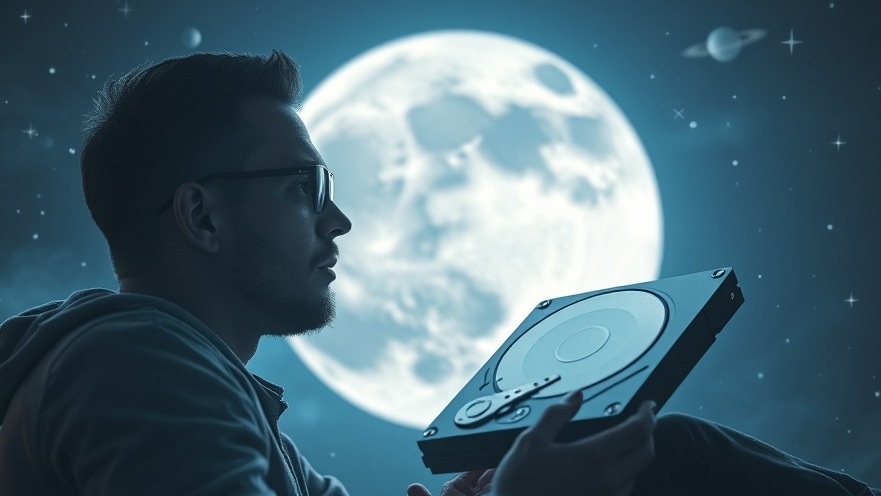
A Groundbreaking Leap: The Future of Data Storage in Space
As humanity pushes the boundaries of space exploration, innovative concepts are emerging that could redefine how we manage and store data. Recently, the Intuitive Machines' IM-2 lunar mission successfully launched a data center designed by architecture firm Bjarke Ingels Group (BIG), marking a historic milestone in the quest to establish physical infrastructure on the moon. This prototype, dubbed the Freedom Data Center, aims to test data storage capabilities beyond Earth.
The Significance of the Freedom Data Center
The Freedom Data Center, measuring just 6 x 17 cm, is more than just a compact piece of technology—it symbolizes a vision for lunar sustainability and resilience. According to Chris Stott, the CEO of Lonestar Data Holdings which collaborated on this project, the lunar data center acts as a 'global backup' for critical information. This revelation comes amidst growing concerns over catastrophic data loss on Earth due to climate change and other crises.
Imagine storing vast libraries of information—an off-site backup akin to a modern-version of the Library of Alexandria—on the moon, powered by ample solar energy and natural cooling solutions. This concept could pave the way for large-scale data centers positioned strategically in lunar tunnels, enhancing disaster recovery capabilities at minimal latency.
Payloads Designed for Lunar Conditions
The IM-2 mission, which launched on February 26, 2025, also carries advanced technological payloads from various institutions. One notable inclusion is Columbia Sportswear's thermal protection technology, the Omni-Heat Infinity and Omni-Shade Sun Deflector. This collaboration aims to ensure that the lander remains functional despite the moon's extreme temperatures. The deployment illustrates the merging of apparel with aerospace engineering, which can inspire fresh ideas for remote workspace solutions here on Earth.
Additionally, Nokia's Lunar Surface Communication System (LSCS) is onboard, aimed at establishing communication benefits for future lunar and Martian expeditions. By enabling a cellular network that connects rovers and drones on the lunar surface, Nokia is venturing into transforming not just our data centers, but the very way we communicate across planets.
Preparing for Future Lunar Missions
The IM-2 mission is not an isolated event; it reflects the burgeoning interest in commercial lunar exploration and the possibilities that lie within. Following a bumpy start with the IM-1 mission, where the lunar lander failed to land intact, the IM-2 mission serves as a precursor to future ambitious projects that may involve extensive human presence and infrastructure on the moon.
As NASA plans to return astronauts to the lunar surface, collaborations like those of Intuitive Machines and Lonestar Data Holdings signal a paradigm shift in the way we think about data and its preservation in an extraterrestrial landscape. This shift holds promise not only for technological advancements but could revolutionize the way digital nomads strategize how and where they manage their data.
Insights for Digital Nomads: What We Can Learn
The launch of the Freedom Data Center presents more than a fresh frontier for data storage; it also offers valuable perspectives for digital nomads seeking to optimize their remote workspaces. Just like the lunar data center, effective workspace design hinges on adaptability, functionality, and sustainability. Ergonomics plays a crucial role here too; incorporating flexible designs can improve productivity while reducing health risks.
Environmental considerations, inspired by the lunar mission’s reliance on solar energy and passive cooling, serve as a reminder to digital nomads: sustainable choices can enhance both workspace efficacy and well-being. By applying these principles, remote workers can create environments that are not only comfortable but also supportive of their health and productivity.
The growing intersection between space exploration and terrestrial benefits emphasizes how advancements in one domain can leverage innovative practices in another. By observing the lunar missions, digital nomads may gain insights into future-proofing their work, such as enhancing data security and employing technologies that could streamline workflow even when faced with geographical challenges. As new systems evolve, it’s crucial to stay informed and adaptable in a rapidly changing environment, much like the flexibility demonstrated by the teams working on the moon.
In conclusion, the IM-2 mission signifies far more than a solitary technological trial; it encapsulates a vision for a future where data storage can be both revolutionary and resilient. By contemplating the implications of these advancements, digital nomads can forge ahead with confidence in creating ergonomically sound and efficient workspaces that echo the ingenuity evident in lunar developments.
To learn more about effective workspace solutions that draw inspiration from these groundbreaking developments, consider exploring the latest ergonomic design practices in your own home or office.
 Add Row
Add Row  Add
Add 




Write A Comment